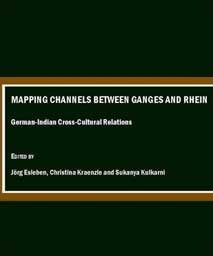Mapping Channels between Ganges and Rhein: German-Indian Cross-Cultural Relations, Jörg Esleben, Christina Kraenzle and Sukanya Kulkarni, eds.
Reviewed by Ashwin Manthripragada
 Jörg Esleben, Christina Kraenzle and Sukanya Kulkarni, eds. Mapping Channels between Ganges and Rhein: German-Indian Cross-Cultural Relations. Newcastle, UK: Cambridge Scholars Publishing, 2008. Pp. 270. Cloth, $69.99.
Jörg Esleben, Christina Kraenzle and Sukanya Kulkarni, eds. Mapping Channels between Ganges and Rhein: German-Indian Cross-Cultural Relations. Newcastle, UK: Cambridge Scholars Publishing, 2008. Pp. 270. Cloth, $69.99.
This volume of essays was born out of a conference of the same title that explores current research in German-Indian cultural relations. Especially valuable for scholars whose particular interests lie in the transcontinental mobilization of Eastern culture, Mapping Channels between Ganges and Rhein is an important step in resurrecting and renovating a connection and theories thereupon that would find interested readers across various disciplines.
In keeping with this interdisciplinary approach, it is divided into four main parts: Surveying Indology, Philosophical Borders, Mapping Literary Currents, and Exploring India in Popular Media. The grouping of the somewhat disparate essays into these categories, along with a highly informative and compelling introduction written by the editors Esleben, Kraenzle and Kulkarni, provides a tight framework within which each essay plays a pivotal role in illuminating the multifaceted discourse at hand. The volume title and the choice of articles themselves can be misleading to the scholar who studies a dialogue not restricted to the one-way influence of Eastern culture upon Europe. Nevertheless, the thorough but quick timeline of events given in the introduction, outlining the ascendancy of India in German discourses from the so-called “Oriental Renaissance” of the 18th and 19th centuries to the Indian immigration of recent decades, points towards a conscientious inquiry into the effect of German culture upon Indian identity as well. The volume is compelling in part because its organization of themes, culminating in consequences of modern globalization, calls for a multidirectional, international discourse. Additionally, each of the four groups listed above, containing from two to four articles, has at least one particularly strong essay that either shows extensive historical study or reveals a new angle from which to view an established discourse.
In part two, for example, Bradley L. Herling’s essay, “The Problem of Action in the Early German Interpretation of the Bhagavadgītā,” confronts “the moral nihilism that [Slavoj] Žižek imposes on the text” by making a careful genealogical study of Žižek’s recent claims on the karmayoga doctrine of the Bhagavadgītā, placing them in a lineage that can be traced back to those of Friedrich Schlegel. Herling finds Žižek’s arguments problematic because Žižek interprets this doctrine in the Gītā based upon its appropriation by German nationalists, including the head of the Nazi Schutzstaffel (SS), Heinrich Himmler. Herling reestablishes a distinction between acting “without regard to the fruits of one’s action (karmayoga)” and acting “as if [one’s actions] didn’t matter,” a distinction that Žižek seems to ignore. The way in which Herling challenges this “widely read ‘pop star’ of contemporary theory” is bold but effective. He does so by bringing the estimations of Wilhelm von Humboldt, which “forge a connection between Hindu ethics and Kant’s practical philosophy,” against Žižek’s views that “supplement a contemporary neo-Orientalist denigration of Indian thought.”
In the final part, Christine Lehleiter’s “How German is the Indian Tiger? The Uncanny as Repressed Familiar in Der Tiger von Eschnapur (Harbou, May, Lang)” employs Freudian theory to reanalyze the Orient of Weimar Cinema. She complicates a claim made by Wolfgang Kabatek, who wrote that “after World War I … the German population was desperately looking for a new collective identity” and that “the exotic, constitutive Other was used to redefine German identity ex-negativo.” Via a close reading of scenes and dialogues from both Joe May’s 1921 and Fritz Lang’s 1959 versions of Eschnapur, each filmed in a post-war period, Lehleiter contends that these films represent, in the realm of the exotic and uncanny, the very experience of wartime in Germany from which a German audience would want to distance itself.
The range of topics in this volume is a testament to a truly interdisciplinary work. By bringing together the cultural with the sociological in “Imagining India Online: Second-Generation Indians in Germany” or by comparing and contrasting contemporary British and German fiction in “India/Sri Lanka, The Holocaust, and the European Gaze in Anita Desai’s Baumgartner’s Bombay and Jeannette Lander’s Jahrhundert der Herren,” this recently published volume approaches its topic from a variety of methodological standpoints. For this reason, some articles lack the scrutiny that a work compiled under one methodology could provide. Nevertheless, the format of this work, including the chapter groupings, detailed footnotes, and above all the indispensible and extensive bibliography, is one on which other volumes of intercultural studies might be modeled. Reflective of a growing, re-emerging field of discourse, this book should be available in academic libraries in both German and South Asian Studies departments.
ASHWIN MANTHRIPRAGADA, University of California, Berkeley
